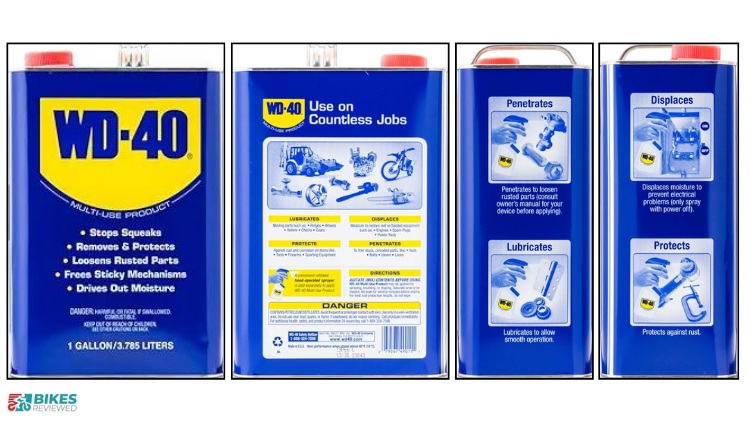If you're a bike enthusiast, you've likely encountered the age-old debate: Can you use WD-40 on your bike chain? It's a question that sparks strong opinions on both sides. Some swear by it as a quick fix for squeaky, sticky chains, while others caution against its long-term effects on your bike's performance. So, let's dive into the details and see what the fuss is all about.
What is WD-40?

Check Price Now
WD-40 is a household name, known for its versatility in lubrication, rust removal, and general bike maintenance. Its name stands for "Water Displacement, 40th formula," indicating its original purpose as a water displacement compound. Over time, it has evolved into a multi-use product, finding its way into toolboxes, garages, and bike sheds around the world.
Proponents of using WD-40 on bike chains argue its effectiveness in loosening stubborn grime and providing temporary lubrication. They highlight its accessibility and affordability, making it a convenient option for quick fixes and on-the-go maintenance. Many riders swear by its ability to silence a noisy chain and improve shifting performance, especially in a pinch.
Why Some Cyclists Avoid WD-40?
On the other side of the spectrum, there's a camp of cyclists who adamantly oppose using WD-40 on bike chains. Their concerns primarily revolve around its composition and long-term impact on chain health. WD-40 is a solvent-based product, meaning it's designed to dissolve and remove existing lubricants, dirt, and grime. While this makes it effective as a cleaner, it also strips away any existing lubrication on the chain, leaving it exposed to wear and tear.
The Importance of Proper Lubrication
Lubrication is crucial for the longevity and performance of your bike chain. It reduces friction between the moving parts, prevents rust and corrosion, and helps maintain smooth shifting. Using the right lubricant ensures that your chain stays in optimal condition, prolonging its lifespan and minimizing the need for frequent replacements.
Choosing the Right Lubricant for Your Bike Chain
When it comes to lubricating your bike chain, not all products are created equal. While WD-40 may offer a quick fix in certain situations, it's not ideal for long-term chain maintenance. Instead, opt for a lubricant specifically designed for bike chains. These products are formulated to withstand the rigors of cycling, providing the right balance of lubrication and protection without attracting excessive dirt and grime.
Types of Bike Chain Lubricants
There are several types of bike chain lubricants available, each with its own advantages and applications:
- Wet Lubricants: These are thicker, oil-based lubricants designed for wet conditions. They provide excellent protection against water and corrosion, making them ideal for rainy or muddy rides. However, they can attract more dirt and grime, requiring more frequent cleaning and reapplication.
- Dry Lubricants: Dry lubes are typically wax or Teflon-based and are designed for dry, dusty conditions. They create a dry, waxy film on the chain, which helps repel dirt and grime. While they may not offer as much protection in wet conditions, they're excellent for reducing friction and keeping your chain clean in dry weather.
- All-Purpose Lubricants: Some lubricants are formulated to work well in a variety of conditions, offering a balance between wet and dry performance. These multipurpose lubes are convenient for riders who encounter a mix of weather conditions and terrain.
How to Properly Lubricate Your Bike Chain?
Regardless of the type of lubricant you choose, proper application is key to ensuring optimal performance and longevity of your bike chain. Here's a step-by-step guide to lubricating your chain effectively:
- Clean the Chain: Before applying new lubricant, it's essential to clean the chain thoroughly to remove any dirt, grime, or old lubricant. You can use a dedicated chain cleaner tool or a rag soaked in degreaser to scrub the chain clean.
- Dry the Chain: Once the chain is clean, allow it to dry completely before applying the new lubricant. This ensures that the lubricant adheres properly to the metal surfaces without being diluted by water.
- Apply the Lubricant: Apply a small amount of lubricant to each link of the chain, focusing on the rollers and pins where most of the friction occurs. Use a steady, even motion to ensure thorough coverage without excess dripping.
- Let it Penetrate: After applying the lubricant, give it some time to penetrate the chain and settle into the moving parts. You can gently backpedal the chain to help distribute the lubricant evenly.
- Wipe off Excess: Once the lubricant has had a chance to penetrate, use a clean rag to wipe off any excess from the surface of the chain. This helps prevent dirt and debris from sticking to the chain and keeps your drivetrain running smoothly.
- Repeat as Needed: Depending on your riding conditions and the type of lubricant used, you may need to reapply lubricant periodically. Pay attention to any signs of wear or excess noise from the chain, and reapply lubricant as necessary to keep it in top condition.
Also read - How to Clean a Bike Chain Without Removing It?
Conclusion
While WD-40 may offer a quick fix for a noisy bike chain, it's not the best long-term solution for maintaining optimal chain health and performance. Instead, invest in a high-quality bike chain lubricant designed specifically for cycling applications.
By choosing the right lubricant and following proper maintenance procedures, you can keep your bike chain running smoothly mile after mile, ensuring a smooth and enjoyable riding experience for years to come.
